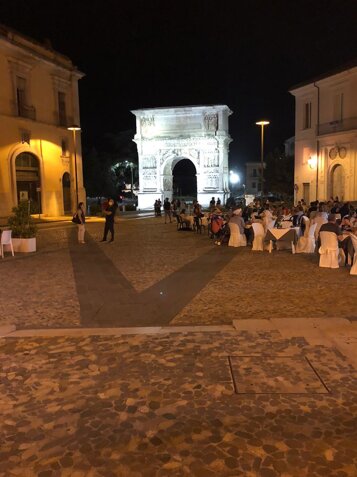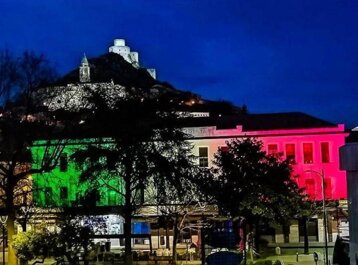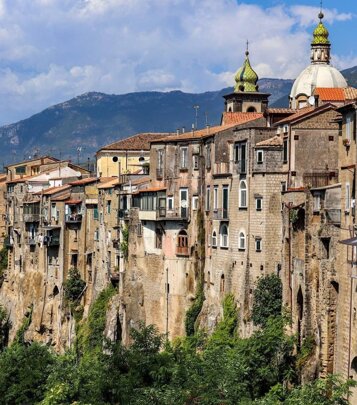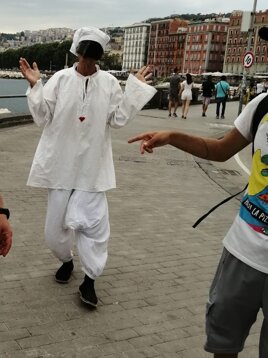© Use of content without authorization is prohibited

Campania
Avellino Benevento Caserta Naples Salerno
Campania impressed me with its cities rich in history, food, folklore, monuments, and archaeological sites, but above all with the passion that you can feel everywhere you go among these welcoming people. I have been to this region several times, often as a guest, but I still have many areas to explore, especially Sannio, Irpinia, and Cilento, which are the naturalistic parts of Campania. Here it is easy to eat well; among my favorite dishes are Eggplant Parmigiana, Gnocchi alla Sorrentina, Neapolitan Pizza, and to finish on a high note, dessert and rum together to create the exquisite Babà. Campanian wines are excellent, especially those from the province of Avellino; among the reds I recommend the Aglianico di Montefusco, while among the whites the Falanghina, which in its sparkling version is among the best wines in the world, at least for me.

Province of Benevento
Area: 2080.51 km² Population: 261,431 Municipalities: 78
travel stories...



Montesarchio
I have been twice to this large town in the Valle Caudina, always a guest of relatives who made the trip unforgettable by taking me to discover every corner of Montesarchio. Starting from the hill where the Tower and the Castle are located, now home to the Archaeological Museum of Sannio Caudino, I visited and learned thanks to the expert guidance of my cousin who at the time was the custodian of the fortress; the dungeons where the Bourbons imprisoned the patriot Carlo Poerio are impressive. From up there, the view is spectacular and you can see the valley all the way to Mount Taburno. Going down towards the center, you come across the Franciscan Church of Santa Maria delle Grazie, beyond which you pass through the fascinating old part with its narrow, cobblestone streets. Further down to the heart of the city, which is Piazza Umberto I with the fountain in the center that is illuminated in the evening. Lights that were not missing on the night of Ferragosto with stalls and fireworks. I conclude by saying that in these days I also delighted my palate thanks to my cousin's homemade cooking.
Sant'Agata dè Goti
Benevento
I was accompanied by my cousin to visit this village at the foot of Mount Taburno. After leaving the car in the parking lot on Via Caudina, we visited the Church of San Menna; on the entrance portal, a Latin inscription warns the faithful to repent of their sins. Certainly, I do not regret this visit to one of the most beautiful villages in Italy. We then take the road that leads to the Roman Bridge over the Martorano River. And here, from the narrow sidewalk on the parapet of the bridge, you can admire a breathtaking view with houses perched over the ravine. In the evening, when everything is illuminated, it feels like living in an enchanting nativity scene. After taking the usual photos, we head back to explore the historic center.
An evening spent in Benevento was not enough to discover all the beauty of this city. But it is enough to lose your head when, at the top of the avenue of the same name, you find yourself in front of the illuminated Arch of Trajan. All around there are squares with noble palaces full of charm, such as the one that belonged to the Rotondi Andreotti Leo family; Baroque churches like that of Santa Lucia or the ancient Lombard Church of Sant'Ilario. Finally, a relaxing walk to admire a UNESCO World Heritage site: at the top of a beautiful square, after passing a tower and an obelisk, I find myself in front of the Church of Santa Sofia and here I promise this city a future visit for new emotions.

Metropolitan City of Naples
Area: 1176.72 km² Population: 2,967,736 Municipalities: 92
travel stories...



Naples: Castel dell'Ovo
Walking along the Caracciolo seafront, with my eyes delighted by the Gulf of Naples and Mount Vesuvius in the background, I lose track of time but not my appetite. After a pizza to satisfy my palate, I continue my walk until I reach a bridge with ancient paving. From there, you can access Castel dell'Ovo. This fortress, built directly on the sea, can be explored both inside and outside its mighty walls, which are illuminated in the evening. Inside, it is bare of furnishings, but it's pleasant to take a photo in front of the cannons that menacingly point through the loopholes facing the city. I end my visit to this splendid castle first by looking at Vesuvius, then at the view of the gulf with Capri and Ischia in the background, and finally by casting one last glance at the city of Naples above which a beautiful sunset stands out.
Pompeii
As a guest of some relatives, I was taken in the morning to the Sanctuary of the Madonna of Pompeii, an imposing church built in the second half of the nineteenth century. Then, after a refreshing granita on a scorching late June day, we arrived at the archaeological site. The excavation area is truly enormous and it takes an entire day to walk around it all. Starting from Porta Marina, you pass through the Forum with the Basilica on the right, which was not a religious building, but rather a courthouse where justice was administered in Roman times. On the left, surrounded by columns, is the Temple of Apollo and further ahead the Temple of Jupiter. Walking along the Via dell'Abbondanza, I was left speechless at the state of preservation of the frescoes in the Roman houses, and finally, sitting on the steps of the Amphitheater, I closed my eyes and imagined life two thousand years ago.
Naples: Caracciolo Seafront
On one of my rare train journeys, I arrived at the Central Station. Out here, at the top of the large square, there is the monumental statue of Giuseppe Garibaldi. After taking a few photos of the hero of the two worlds, I took the bus towards Mergellina. Getting off at the Piedigrotta stop, I crossed the beautiful Sanazzaro square with the Fountain of the Siren Parthenope, the ancient Greek name of the city, at its center. From there I headed to the port where the Lungomare Caracciolo begins, the most famous promenade in Naples; famous and characteristic, where you can meet amusing characters like the Pulcinella mask.